Agricultural and Biological Research
RNI # 24/103/2012-R1
Research Article - (2023) Volume 39, Issue 2
Indigenous knowledge is a localized knowledge that is acquired by locals through their experiences, informal experiments, and familiarity with their local environment. The knowhow of cattle diseases diagnosis and treatment practice using indigenous knowledge play a key role to improve farming and animal husbandry practices. The farmers of rural area use indigenous knowledge for diagnosis and treatment of cattle diseases, but currently this knowledge was disappearing because of not properly collecting, storing, sharing and applying. The aim of this study was to explore indigenous knowledge for cattle diseases diagnosis, treatment and modes of application. The exploratory research method was used and data collection instruments were focus group discussion, observation, and interview. The populations of this study were selected farmers of six (6) Kebeles who have a good experience on the area. The attained data showed that, people in the study area have good perception and practices on the indigenous knowledge medicine of cattle diseases diagnosis and treatment. The drugs of the knowledge practices are easy to access and very little in cost, it is economically important to the farmers. The knowledge practices were accessed from elders and transferred through orally. To acquire, share, store indigenous knowledge medicine, local herbalist, poem and heroic tale mechanisms were used. This kind of valuable knowledge need to be stored transferred and preserved for the next generation. Documenting indigenous knowledge is very crucial to avoid the loss of this indigenous knowledge practices in the Kebeles.
Indigenous knowledge; Diagnosis and treatment; Mode of application; Cattle diseases; East Wollega
Indigenous knowledge is the type of knowledge that is available in the mind of knowers. It is difficult to transfer to another person by means of writing and verbalizing since it is not documented. This type of knowledge was generated at local area by indigenous people through interacting with the environment, know-how to accomplish and practices maintained and collected by peoples through generations [1]. Akullo [2] defined indigenous knowledge as ideas, beliefs, values and norms which are embedded in the minds of people. This knowledge is collected over a long sequence of observations and transferred from generation to generation orally.
Indigenous knowledge plays a key role in improving sustainable farming, animal husbandry practices, increasing the livelihood and disease treatment [3]. According to Belay [4], indigenous knowledge medicine practices are knowledge and beliefs, integrating with the use of plant, mineral and other animal as drugs. This type of practices was used singularly or in combination to treat, diagnose and prevent illnesses, and to maintain well-being. Indigenous knowledge is the sum total of all knowledge and practical experience used for disease diagnosis, prevention, elimination and observation handed down from generation to generation verbally [5]. Indigenous knowledge medicine was practices of animal health care as a process based on skills of traditional knowledge and methods used for curing diseases and maintaining health of animals [6].
In different developing countries, this knowledge provides for communities for problem solving strategies in various activities such as in health sector, education, natural resource management and in agriculture to support and maintain sustainable agricultural crop land management, animals production and climate change adaptation and mitigation [7]. According to Endashaw [8], traditional medicine in Ethiopia has been widely used by various ethnic groups and about 90% of livestock population depending on traditional medicine and most of it comes from plants. In Ethiopia 80% of the population used traditional medicine due to the cultural acceptability of healers, the relatively low cost of traditional medicine and difficulty of access to modern health facilities [9].
A cattle have a numerous uses, for instance for income generation, serve for milk, meat for household consumption, manure for fuel and fertilize; and foreign exchange to the country. The contribution of cattle in the Ethiopian economic context can generally be categorized in terms of food production, supplier of inputs and services for crop production, raw material for industry, cash income and export earning, saving and investment, social functions and generator of employment.
Indigenous knowledge medicine practices for cattle health care is the only asset in the hands of farmers and/or cattle holder to mitigate the impact of cattle diseases treatment and production. There are different types of cattle diseases that affect cattle production in several ways. These cattle diseases have negative effects on international market export; decreases cost of production, reduce the quantity of products and generally cause great loss of income of the farmer. Modern science to diagnosis and treat cattle diseases in the form of veterinary service may not always be readily available to rural farmers. But, to diagnosis and treat different types of cattle diseases indigenous people know a lot about how to prevent and treat different diseases in traditional methods. For example, they use (hora obaasuu) to treat cattle suffering from scabies (cinii), stomach diseases and skin problem, whereby cattle are taken a water body rich in mineral to drink for a few days.
Therefore, in different areas, indigenous knowledge medicine practices of cattle diseases diagnosis and treatment still play an important role. But the mode of application of this knowledge was not equally employed from one local area to another since it given to a specific culture or society and is not organized. Indigenous knowledge practice is only medical practices accessible to the majority living in the remote areas, but currently different youth thinks as a backward practice because it is not in standard format [10].
Even, indigenous knowledge medicines contributed to innovation of modern medicine, for instance the user of this knowledge becoming fewer and fewer in number; since this knowledge was going to be lost [11]. Indigenous people want to use indigenous knowledge medicine practices of cattle diseases prevents and treatment since it is cheaper and more accessible in society. However, individuals who are knowledgeable in traditional practices usually try to keep the knowledge secret and remain unwilling to openly teach to others [12], because rights of ownership are not protected. This is one of the causes for losing of indigenous knowledge and indigenous people are becoming fewer and fewer in number. On the other hand, indigenous knowledge has not been well incorporated in development interventions [10]. Moreover, indigenous knowledge is local or environmentally specific in nature and transmitted orally, the mode of application and preparation in different area and way of preservation also another problem [13].
Therefore, this study attempt to identify common cattle diseases identified prevented and treated using indigenous knowledge practices and clarify the mode of preparation and application of the drugs by indigenous people in the study area.
The exploratory research design was used to conduct this study. This method was used to gather information about indigenous knowledge of cattle disease treatment and its modes of application practices from primary data sources in the study that is not available from other sources or documented.
Population of the study
The study population for this research was indigenous knowledge practitioners of selected Kebele of East Wollega Zone. The target population of the study was farmers of six (6) selected Kebeles namely Leka Dullechaa Woreda (Hordaa Dongii and Keweessa Shonaa Kebeles), Guutoo GiddaaWoreda (Jireenyaa and Gaarii Kebeles) and Giddaa Ayyaanaa Woreda (Guutee Guddinaa and Oboraa Kebeles). The six (6) kebeles were selected based on their experience of indigenous knowledge practices for cattle diseases diagnosis and treatment in the local community.
Sample technique and size
To conduct this study, researchers used purposive sampling to select a total of 107 respondents from six (6) kebeles of the local communities. For sample size, 12 (twelve) focus group discussions with at least seven (7) to nine (9) maximum members of elder people totally ninety six (96) respondents were selected and eleven (11) respondents were selected for interview from three Woreda. This purposive sampling approach was employed because of to prove effective when only limited numbers of respondents can serve as primary data sources due to the nature of the research design, aims and objectives.
Data collection instruments
Focus group discussion, interview and observation were used to collect necessary data from the respondents.
Accessibility of indigenous knowledge practices in community
Accessibility is the way in which farmers of the study area access the indigenous knowledge for solving different problems as locally. As the finding of the study stated that, there are various types of indigenous knowledge that approved in this community for a long time. Farmers of this area use this knowledge in order to solve different problem. For instance, as respondents of the study mentioned, this type of knowledge was valuable in the community to prevent and treat different diseases of both livestock and human being. Also the finding of the study stated that farmers in the community use this knowledge to crop production, environmental conservation, land use management, protection of plants and for preserving and conserving water. As a result of the study shows, there are two types of healing and treat different diseases. This was a healing and diagnosis through modern and through indigenous knowledge. However, from these types of diagnosis and treat different diseases, farmers in the study were applied indigenous knowledge medicine to treat different cattle diseases. The finding shows that the reason to use this knowledge in this area includes it easily accessible to the community and the cheapest in the study area. The finding of the study also confirmed that, this kind of knowledge was transformed from herbalist to child, neighbor through orally and also gifted from God. Moreover, further finding of the study based on accessibility of indigenous knowledge practices in community shows that, these traditional medicine practitioners are usually farmers, hunters, fishermen; timber workers usually above 50 years of age. Transfer of knowledge and skills of the practices were mainly through family inheritance, only very few practitioners developed their skills through apprenticeship.
The study finding indicates that, the cattle are usually caused by different diseases either through contact with diseased animals or due to improper sanitation, feeding, care and management. As the result of this study shows, lack of cattle shelter were the most cited cause of cattle ailments in the study area which scores 53.3%. Also the finding of the study stated, 21.5% were caused from stored water, 31.8% were caused from grass grew in cattle breeds, 8.4% were caused from colobus monkey urine, 11.2% were caused from urine of hyena, 15.9% were caused from grass grew in urine of hyena, 6.5% were caused from when they mixed with others wild animals, 13.3% were caused from insects, flies/dust, 8.4% were caused from sharp objects pricking the eye, 16.8% were caused from their poor blood circulation, 19.6% were caused from when cattle overfeeding and 33.6% were lack of grasses and water in their area. As cattle diseases were caused from different sake, also herbalists know different practices used to prevent and treat various diseases. However, from this practice indigenous knowledge medicine was the main known practices used in the community. This indigenous knowledge practices was the approach of using local knowledge to prevent and treat different diseases locally.
Purpose of using indigenous knowledge practices
As different herbalists mentioned the purpose of using indigenous knowledge medicine in study area, 69.2% were used for treat human diseases, 86.9% were used in order to livestock husbandry and diseases treatment, 52.3% were used for crop production, 35.5% were used for environmental conservation, 59.8% were used for land use management, 21.5% were used for plants protection and 29% were used for conserving of water. So, for solving their problems, farmers from the study area were used indigenous knowledge practices in order to answering their difficulties as the local community (Table 1).
| Purpose | Percent % |
|---|---|
| Human disease treatment | 69.2 |
| Livestock husbandry and disease treatment | 86.9 |
| Crop production | 52.3 |
| Environmental conservation | 35.5 |
| Land use management | 59.8 |
| Protection of plants | 21.5 |
| Preserving and conserving water | 29 |
Table 1: Purpose of using indigenous knowledge practices.
Source of indigenous knowledge medicine practices
As the finding of a study exposed, indigenous knowledge practices were obtained from different sources. As the data collected from the study area show that the source of this indigenous knowledge practices was from herbalists, neighbor, God and acquired through trial and error. In percentage 20.6% of respondents acquired this knowledge from God, 29% educated from grandfather/grandmother, 24.3% learned from neighbor of traditional healers, 43.9% learned from their father/mother, 17.8% learned through trial and error, 22.4% learned from their husband/wife, 18.7% learned from sister/brother, 16.8%) learned from their uncle/aunt and the left 8.4% acquired this source of knowledge from their In-law.
Source of indigenous knowledge drugs preparation for cattle
The finding of the study stated that, there were various sources of indigenous knowledge medicine practices used to prevent and treat different cattle diseases. The main sources used to prepare this medicine were plants, mineral and animals. As the result of this study shows, plant was the main sources used to prepare indigenous knowledge medicine for cattle diseases in the study area which scores 71% was drug prepared from plants, 21.5% was prepared from minerals and the rest 7.5% of indigenous knowledge medicine was prepared from animals (Figure 1).
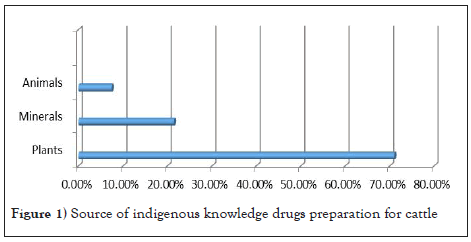
Figure 1: Source of indigenous knowledge drugs preparation for cattle.
The finding of this study also stated, fruits (daraaraa biqilootaa), roots (hidda biqilootaa), seeds (ija biqilootaa), leaves (baala biqilootaa), barks (qola/jirma biqilootaa) and dependent plants was certain plant parts used during drug preparation. So, the result of the study confirmed 28% drugs were prepared from plants, fruits, 35.3% drugs were prepared from plants’ roots, 23.4% drugs were prepared from plants’ seeds, 67.3% drugs were prepared from plants’ leaves, 40.2% drugs were prepared from plants barks and 22.5% drugs were prepared from some dependents plants available on other plants.
Moreover, the result of the study also cited that indigenous knowledge medicine practices were prepared in several rather standardized ways which usually vary based upon the plant utilized and what condition is being treated. Therefore, as the finding of this study, this drug/medicine was prepared in the form of crushing, squeezing, chewing, fumigating, chopping, extract with cold water, roasting, in the form of wrapping and heating different plant parts with water, honey, ash, minerals and other animals meat or skin. Additionally, the finding of the study confirmed this knowledge medicine practices was applied in the swallowing, fever body part, put on, fumigating and through bleeding tongue. However, this mode of application was implemented based on the symptoms shown on the cattle or types of cattle diseases.
Indigenous knowledge practices for cattle diseases diagnosis and treatment
According to the World Health Organization, at least 80% of people in developing countries depend largely on indigenous knowledge for the control and treatment of various diseases affecting both human beings and animals [14]. As information accessed from different herbalists of study area, there are a lot of cattle diseases known in this area. However, as the numbers of cattle diseases are there, also they know different methods/mechanism for prevent and treat based on the symptoms available on their cattle. The following Table 2 below shows that the overall types of cattle diseases known in the study area with their well-known symptoms (Table 2).
| No | Local name of cattle diseases | International name of cattle diseases | Symptoms |
|---|---|---|---|
| 1 | Bishooftuu | Blackleg |
|
| 2 | Qoraattii-arrabaa | Actinobasilosis |
|
| 3 | Abbaa-sangaa | Anthrax |
|
| 4 | Maasaa |
|
|
| 5 | Gandii | Trypanosomiasis |
|
| 6 | Maaree | Skin disease |
|
| 7 | Dhiiga finceessisaa | Bloody urination |
|
| 8 | Simbira | Bird |
|
| 9 | Garaakaasaa/dhoqqeeqal’isaa | Paratuberclosis |
|
| 10 | Gatachiisaa | Brusulosis |
|
| 11 | Dhukkuba ijaa | Pink eye |
|
| 12 | Dhiitessaa/muchaadoomsaa | Mastait/ Breast cancer of cattle |
|
| 13 | Mandaraarraa | Foot and mouth diseases (FMD) |
|
| 14 | Dhulla | Swelling |
|
| 15 | Furfuraa | Blotting |
|
| 16 | Cittoo /Qanxoo | Scabies |
|
| 17 | Gororsiisaa | Pasteurellosis |
|
Table 2: Indigenous knowledge practices for cattle diseases diagnosis and treatment.
Modes of indigenous knowledge medicine preparation and application of cattle disease treatment
As data obtained from respondent of the study area, there are numerous plants accessed in this community to diagnosis and treat different cattle diseases. Table 3 below shows the image of the information about the plant and its mode of preparation (Table 3).
| No | Image | Local name | Scientific name | Diseases it cures | Parts of the plant used | Mode of preparation |
|---|---|---|---|---|---|---|
| 1 | 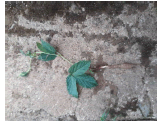 |
Faca’aa | Cucumisficifollius | Bishooftuuf | Hidda (root) |
Pounding the roots and mix with water and then swallowing. |
| 2 | 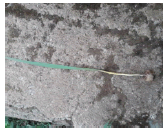 |
Kallachoo | Combretumaculeatum | Dhiiga finceessisaaf (bloody urination) Gaararraaitti dabalanii |
Hundee (root) |
Pounding the roots and mix with water and then swallowing. |
| 3 | 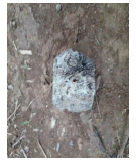 |
Nicotianatabacum | Gandiidhaaf, garaa ciniinnaaf, raammoo garaa keessaaf | Parts | Pounding and mix with water and then swallowing. | |
| 4 | 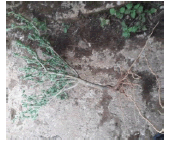 |
Kottefardaa | Sidaschimperana | Dhoraaf, dhukkuba gogaaf | Baala (leaves) |
Pounding the leaves and swallowing the water. |
| 5 | 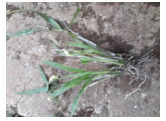 |
Maxxantuubunaa | Englerinawoodfordioides | Dhoraaf | Baala (leaves) |
Pounding the leaves and swallowing the water. |
| 6 | 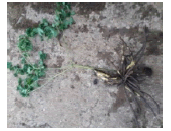 |
Siraabusoo | Thalictrumrhynchocarpum | Bishooftuuf | Hidda (roots) |
Pounding the roots and swallowing the water. |
| 7 | 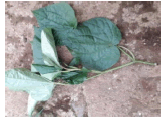 |
Tunjoo | Piper capense | Maaree | Baala (leaves) |
Pounding the leaves and swallowing the water. |
| 8 | 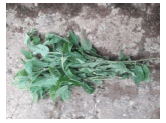 |
Kisee | Ocimumlamifolium | Dhiitoof | Baala (leaves) |
Pounding the leaves and swallowing the water. |
| 9 | 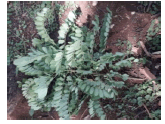 |
Ceekaa | Calpurnia aurea | Ciniif, injiraanii fi tafkiif | Baala (leaves) |
Pounding the leaves with water and wash their skin. |
| 10 | 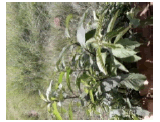 |
Eebicha | Vernonia | Mucha doome banuuf, aannan baasuuf | Baala (leaves) |
Breed after collect the laves |
| 11 | 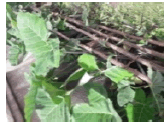 |
Goodarree | Colocasiaesculentum | Dilluu garaatti hafe baasuuf | Baala (leaves) |
Pounding the leaves and swallowing the water. |
| 12 | 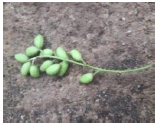 |
Qomonyoo | Bruccaantidysenterica | Madaaraammoo baaseef | Ija (seeds) |
Pounding the seeds and swallowing the water. |
| 13 | 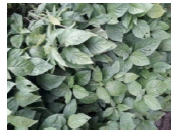 |
Dhummuugaa | Justice schimperiana | Gororsaaf | Baala (leaves) |
Breed after collect the laves. |
| 14 | 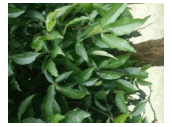 |
Hadheessa | Tecleanobilis | Dhiitoof | Baala (leaves) |
Pounding the leaves and swallowing |
| 15 | 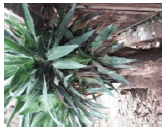 |
Afarfattuu | Dracaena steudneri | Dil’uu kan buusuu diddeef, Bishooftuuf. | Jirma/ hidda (crab/ roots) |
Pounding the roots / barks and swallowing |
| 16 | 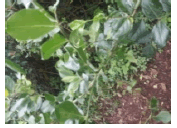 |
Hagamsa | Carissa spinarum | Mucha doomeef | Baala (leaves) |
Pounding the leaves and swallowing |
Table 3: Plant name and part used for cattle disease treatment.
Mechanism to store, preservations and transfer of indigenous knowledge
The study finding revealed that, this indigenous knowledge practices was not existed in the documented format, but passed from generation to generation through interacting with the environment. So, for store and preserve this kind of knowledge medicine practices, different local herbalists protects the source of drugs (plants, minerals and other animals used as medicine). Also, herbalists of study area used different mechanisms to transfer this knowledge from generation to generation through working together and through telling history to the new generation.
As the result of study stated that, there are several challenges to preserve, store and transfer this knowledge. The main challenge that different herbalists mentioned in the results was most of children of herbalists and other young were not willing to receive the knowledge by considering the practice as a primitive or manifestation of uncivilization and think as backward practice. Also, the finding of this study clarifies another challenge to transfer indigenous knowledge was most of both female and male young perceived indigenous knowledge as an outdated knowledge. Moreover, poor recognition on indigenous knowledge, negative attitudes and lack of awareness, as well as lack of interest to share and received from each other, lack of fitting intellectual property right for the herbalists and lack of similar mode of drug preparation and implementation was another challenge to preserve, store and transfer this knowledge medicine practices in the community. Furthermore, as the finding of the study stated that, there are a lot of challenges that occur during indigenous knowledge medicine practices preparation and implementation. However, the lack of correct storage measurement during application, drug contamination and imperfect preparation was the main challenges that occur during indigenous knowledge medicine practices of cattle diseases prevent and treatment.
Strategies used to store, preserve and transfer indigenous knowledge
According to the finding of study area, different herbalists cited several strategies that used for store preserve and transfer this knowledge medicine practices. For instance, make it as internationally modes of application and preparation, done strong study based on this indigenous knowledge, teaching new generation as it is historically, make it clear as it is sources of income and make it familiarity in case of law and/or legally and officially was the main strategies obtained from the result of study.
This research explored indigenous knowledge medicine used for cattle diseases diagnosis, treatment and modes of drug preparations and applications. In this local area, indigenous knowledge have valuable in different sector. The finding of the study showed that local communities of study area use indigenous knowledge practices highly in the diagnosis and treat different cattle diseases. So, herbalists in this area applied their knowledge to safeguard their cattle and treats different cattle diseases like Trypanosomiasis (Gandii) and Blackleg (Bishooftuu) based on the symptoms of cattle illness. This type of knowledge was transformed from generation to generation through oral from father, uncle, aunt and neighbor to child. Additionally, this indigenous knowledge medicine practices used for diseases diagnosis and treatment were prepared in the form of homogenizing in water, crushing, squeezing, chewing, smoking/fumigating, chopping, extract with cold water, roasting, wrapping, sniffing, heating, and swallowing. For safeguard the loss of this knowledge, local community of the study area should be involved in conservation and management of plant resources, minerals and their indigenous knowledge in their locality to generate this knowledge for future generation. Identifying effective medicinal plants and encouraging the local people to grow medicinal plants in home gardens, mixing with crops, coffee farms are some one of the future works.
We would like to thank Jimma University, Jimma Institute of Technology for financial contribution to conduct this research. We also wish to thank all participants of this study for their cooperation and letting us collect data for our work in their offices. Lastly, our special thanks goes to selected farmers of six kebeles of east Wollega Zone (i.e, Leka Dullechaa Woreda (Hordaa Dongii and Keweessa Shonaa Kebeles), Guutoo Giddaa Woreda (Jireenyaa and Gaarii Kebeles) and Giddaa Ayyaanaa Woreda (Guutee Guddinaa and Oboraa Kebeles). Finally, we thank the office of veterinary medicine of east Wollega zone.
[Crossref] [Google Scholar] [PubMed]
[Crossref] [Google Scholar] [PubMed]
Citation: Asefa M, Diriba C, Tesema W. Exploring indigenous knowledge for cattle diseases diagnosis, treatment and modes of application. AGBIR.2023; 39(2):496-502.
Received: 06-Feb-2023, Manuscript No. AGBIR-23-88746; , Pre QC No. AGBIR-23-88746 (PQ); Editor assigned: 10-Feb-2023, Pre QC No. AGBIR-23-88746 (PQ); Reviewed: 24-Feb-2023, QC No. AGBIR-23-88746; Revised: 03-Mar-2023, Manuscript No. AGBIR-23-88746 (R); Published: 10-Mar-2023, DOI: 10.35248/0970-1907.23.39.496-502
Copyright: This open-access article is distributed under the terms of the Creative Commons Attribution Non-Commercial License (CC BY-NC) (http:// creativecommons.org/licenses/by-nc/4.0/), which permits reuse, distribution and reproduction of the article, provided that the original work is properly cited and the reuse is restricted to noncommercial purposes. For commercial reuse, contact reprints@pulsus.com This is an open access article distributed under the terms of the Creative Commons Attribution License, which permits unrestricted use, distribution, and reproduction in any medium, provided the original work is properly cited.
